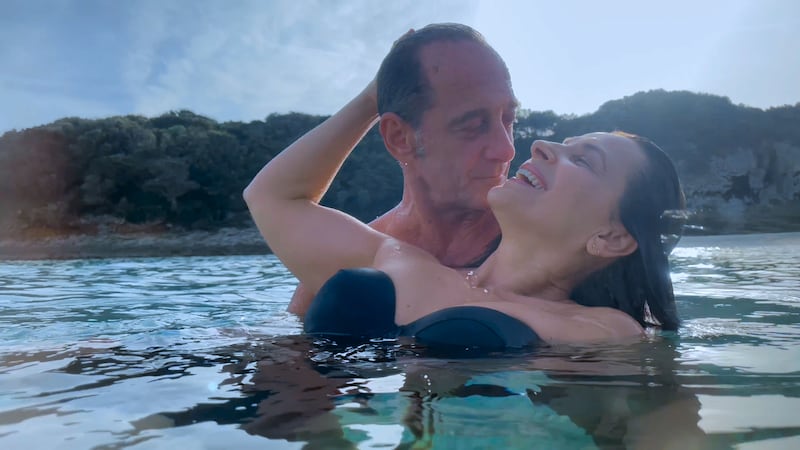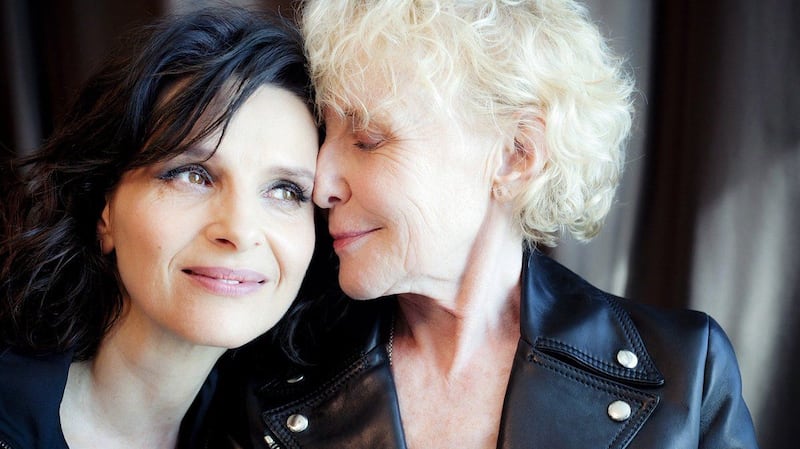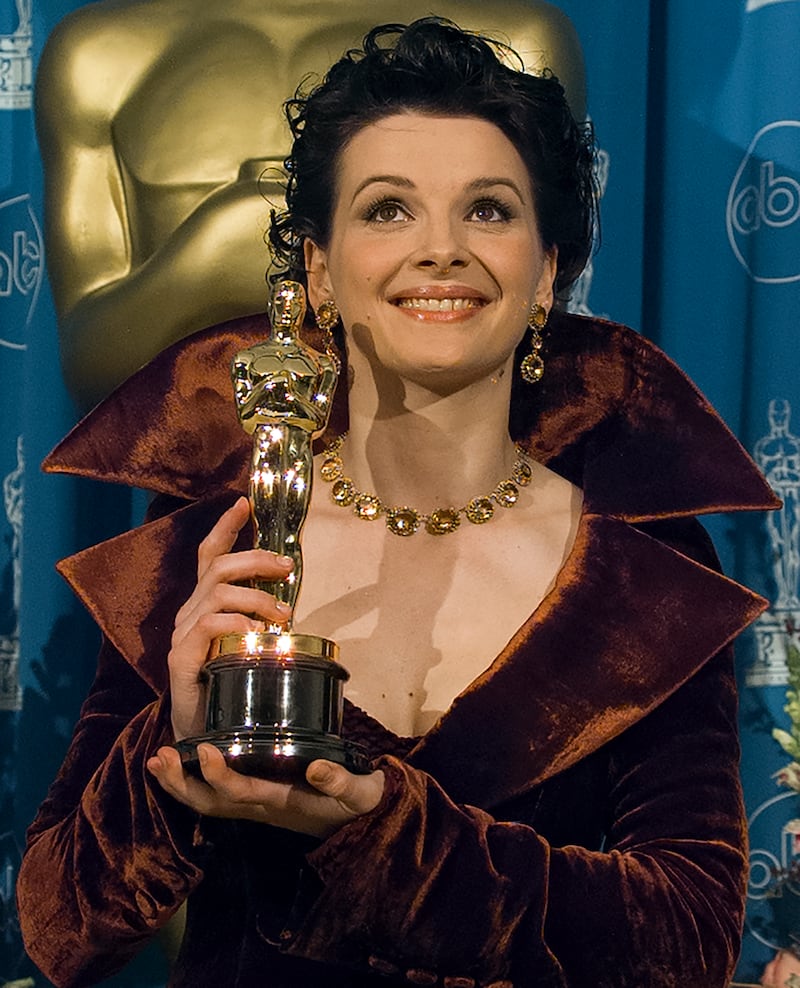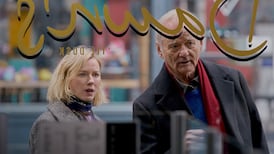In 1988, Juliette Binoche made her Anglophone debut in The Unbearable Lightness of Being as one point of a love triangle: a shape otherwise occupied by Daniel Day-Lewis and Lena Olin. It was a film characterised by a contemporaneous review in the Guardian as “very little speaking, a lot of sulky staring and an incredible amount of frenzied bonking”.
“I know that situation in the film, because it happened to me to be in love with two men together,” says Binoche. “I remember it was just a nightmare. So painful for everyone. So when this film came along I thought, oh, that’s an interesting situation to play. I thought it was worth making the film and putting myself through that even though the theme is very painful. And I have to say the shooting was quite painful as well because it felt like you needed to be wrong. It was a brutal shoot. Who wants to go through that conflict again? But when you’ve passed it, it’s a courageous situation in a way. Some people would call it weak if you were to feel something for someone else in a relationship. Because you have to be faithful in a relationship. But of course, life is more complicated than that because you cannot put your heart in a fridge or a freezer.``
And yet, for all her — to borrow an oft-used phrase — ‘fiercely guarded personal life’, Binoche can sound entirely unguarded about, say, that time she was ‘in love with two men together’
This summary is the very essence of the woman that the French reverentially call “La Binoche”.
For some 35 years, interviewers of all stripes have been politely, typically good-naturedly, shut down for asking Binoche about her three successive domestic partners: professional scuba diver André Halle (from 1992–1995); French actor Benoît Magimel (who was on the scene between 1998–2003); and American actor Patrick Muldoon who was Binoche’s partner from 2003–2005and again from 2014 until, well, now, so far as we know.
For an actor who has won an Academy Award, a Silver Bear at Berlin, a Cannes Film Festival Award, a Bafta, Venice’s Volpi Cup and a César Award, she lives privately without any degree of fuss in Paris. She has two adult children who have grown up in similar anonymity: son Raphaël (29), whose father is André Halle and daughter Hana (23) who was fathered by Benoît Magimel.
And yet, for all her — to borrow an oft-used phrase — “fiercely guarded personal life”, Binoche can sound entirely unguarded about, say, that time she was “in love with two men together”.

She’s equally unguarded about expressing unconventional opinions. During the Covid pandemic, she took to her Instagram account to call for resistance against Bill Gates and “international financial groups, mostly Americans”.
She has not expressly defended the disgraced mogul Harvey Weinstein, with whom she worked on Chocolat (earning an Oscar nod in the process) and The English Patient, for which she won the Academy Award for best actress in a supporting role in 1997. She has, however, been less condemnatory than many others. Speaking to Le Monde in 2017, she praised his work as a producer and distributor of auteur-driven films and claimed: “I never felt in danger with him, because I think I was already armed. The one time I heard a verbal sexual innuendo from him, I didn’t take it seriously.” Speaking as the head of the jury at the 2019 Berlin Film Festival, she said: “I almost want to say peace to his mind and heart, that’s all. I’m trying to put my feet in his shoes. He’s had enough, I think.”
She’s outspoken about directors who behaved inappropriately. She has called her former boyfriend, Leos Carax “a sadist”. During the troubled production of Carax’s Les Amants du Pont-Neuf — a doomy romance concerning two Parisian vagrants Alex (Denis Lavant) and Michèle (Juliette Binoche) — she almost drowned: “I was at the bottom of the water and I couldn’t get up. Coming up to the surface, I chose life at that point.”
She’s visibly unnerved recalling Damage, Louis Malle’s controversial drama in which Jeremy Irons’s English politician embarks on an affair with his son’s French fiancee (Binoche). During that production, she felt “humiliated” and walked off the set twice. The process of making Both Sides of the Blade was less fraught and yet the work was raw enough to bring that earlier experience flooding back.
“I’ve spoken about Damage a lot,” she says. “That was the sort of film it was. It was exhausting. Since then, I’ve been training so that when the day is over, it’s over. I go back to my life. Even now, when I don’t have to take care of children or read their stories before going to bed. But at the beginning, as a young actress, it was very hard to separate from the role. Most of the time, I was getting sick. At the end of shooting, I would get a fever because it was so hard to separate from the crew. You get attached like they are your family. And you are so into the character you are playing. When you’ve reached a place for a scene where you need to go, it can happen that the director doesn’t want to take. And then you play it over and over and over because somehow it’s not finished in you. You haven’t done what you thought you needed to explore. I was surprised that I felt so delicate after Both Sides of the Blade. Working with Vincent was not always easy. It was difficult in a way that surprised me. That hasn’t happened to me in a long time.”
Claire Denis is one of a rather long line of auteurs who have queued up to work with Binoche
It wasn’t all bad. Following on from Let the Sunshine In and High Life, Both Sides of the Blade is Binoche’s third collaboration with director Claire Denis since 2017. The two women have known each other since Denis was a casting director on Andrei Tarkovsky’s final masterpiece, The Sacrifice.

In 1988, Denis asked Binoche to star in her debut feature, Chocolat (not to be confused with the Lasse Hallström Oscar-contender of the same name, starring Binoche and Johnny Depp). Binoche turned her down, but the women stayed in touch.
“I love the way Claire shoots,” says Binoche. “I love the way she works because it feels that it’s related to a hard place. You know, when she’s choosing her shots that it’s not coming out of the school of logic that you can sometimes see in the way that other directors are choosing the shots. She makes films that are everyday life but are operatic as well. Each time working with her, it’s quite different, but there’s something quite feminine about the films she’s doing. And there’s a deep need to respect the dignity of each human being. Her scripts are always interesting and can be quite unconventional. I feel she will protect me. She writes but her filming is also a way of writing. She gives freedom to actors.”
She throws her head back and laughs: “I’m very keen on freedom.”
Denis is one of a rather long line of auteurs who have queued up to work with Binoche. Two of her earliest film roles were for New Wave titans André Téchiné (Rendez-vous) and Jean-Luc Godard (Hail Mary) in 1985. She collaborated with Michael Haneke on 2001′s Code Unknown and 2005′s Caché. She worked with Bruno Dumont on Camille Claudel and the absurdist comedy, Slack Bay. She has made five films with Olivier Assayas. She appeared in all three instalments of Krzysztof Kieślowski’s Three Colours Trilogy. She has made a considerable impact on world cinema, working with the late Belgian Chantal Akerman, Japanese film-makers Naomi Kawase and Hirokazu Kore-eda, Iran’s Abbas Kiarostami, Taiwan’s Hou Hsiao-hsien, and Canada’s David Cronenberg. She played Mary Magdalene for Abel Ferrera, Wuthering Heights’ Cathy Linton, and novelist George Sand for director Diane Kurys.
What these film-makers all have in common, says Binoche, is that they love actors: “And they know how much they owe to actors and they’re not frightened to say that. And you feel that on set. There’s a real respect because they know how much we need to work together. There’s a codependence, even though at the end, they choose the takes and they choose the editing. Auteurs find their own way of telling a story. They’re not frightened to be themselves. They don’t try to fit in. There’s a need for freedom in their way of expression that I love. It’s a joy. It’s as simple as that. They are enjoying what they do, you know? That’s really the common denominator with all those directors. Even if there’s anxiety as well.”
Binoche was born in Paris in 1964 to two actors: Jean-Marie Binoche, who was also a sculptor, and the Polish emigre Monique Yvette. When Juliette turned four, her parents, who were divorcing, sent her and her older sister to the provincial boarding school where her grandmother was working as a cook. She began acting during her teens as a way of getting her family’s attention.
“What I know is that I was when my mother proposed to me to listen to music or go to see theatre or to paint or to dance or to study theatre because she taught a theatre class: I was always for it,” recalls Binoche. “I always said yes to whatever she was proposing. I would dance in front of her and make her happy. Arts were always part of our basic life. It was never the case — not even as a teenager — that I thought no, I don’t want this. It was always just a big yes to whatever. I think that’s how she educated me. There was no resistance. Also probably because when I was younger, I didn’t see her as many times as some kids would see their parents. The need to be with her was bound up with arts, the love of arts, and the joy that it brings.”
The only thing you really can encounter is your own truth. That’s the most crucial art. To achieve in your life, you must be tuned with what you feel
— Juliette Binoche
She remains open to various lively muses. She painted her character’s artworks for Les Amants Du Pont Neuf and for the book Portraits in Eyes. Aged 44, she debuted in the dance production in-i, choreographed by Akram Khan at London’s National Theatre. On stage she’s appeared in Harold Pinter’s Betrayal on Broadway and Sophocles’ Antigone on the West End.
“It doesn’t matter what you do,” she says. “The only thing you really can encounter is your own truth. That’s the most crucial art. To achieve in your life, you must be tuned with what you feel. Your thoughts are related to what you feel and how you act. And it’s difficult to achieve because people are pleasers, you know.”
She breaks off and smiles: “I know that’s not what we were talking about. I could direct movies or plays, but I’ve been spoiled. I’m still spoiled. It’s hard for me to have time in order to do that because I feel: oh, I’m going to be playing with this person or acting with that person. There are so many different encounters and possibilities.”

It can be impossible to predict just what encounters and possibilities Binoche will respond to. Across the Atlantic, she said no to Steven Spielberg for Jurassic Park, Indiana Jones and the Last Crusade, and Schindler’s List. She has criticised both Spielberg and Martin Scorsese for making films with “no parts for women”. Conversely, she appeared with Steve Carell in the largely forgotten Dan in Real Life. Some years later, she agreed to die in the first act of the 2014 Hollywood remake of Godzilla.
“I love working in English because it requires more work for me,” she says. “Because some of the expressions are not mine, and I don’t know them, I’ve got to learn new combinations of expressions or words.”
Binoche’s best later performances in such films as Certified Copy and Clouds of Sils Maria frequently blur the line between fact and fiction, truth and duplicity. In Both Sides of the Blade, Sara, her apparently happily married character, becomes obsessed with a former lover. Watching Binoche’s performance, it’s impossible to tell how much Sara is lying to her husband, her lover, or herself.
“It seems to me that this theme is really what life brings us,” she says. “Where is reality and where is my projection? What is the truth? When we dream about something, where is reality? When we wake up, it’s another reality. And when we die, where is reality? What is fact and fiction is an important theme because it brings all these questions.”
Both Sides of the Blade opens September 9th



















